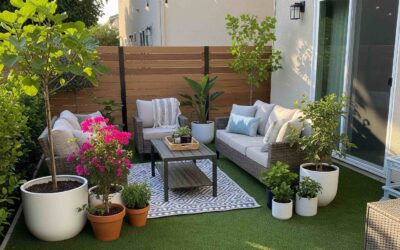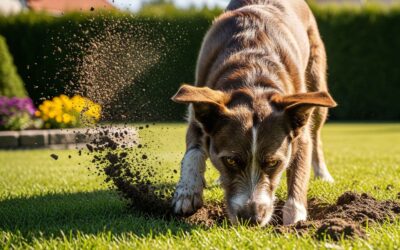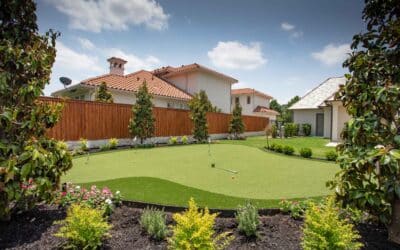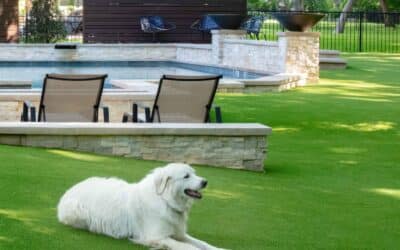Read time: 6 minutes
How To Maintain Artificial Grass?
What’s the main difference between a patch of artificial grass that lasts for eight years and one that lasts 15-20 years?
If the installation quality and levels of traffic are more or less equal, the main factor is how well the grass is maintained.
You don’t need to mow, trim or fertilize your grass or worry about weeds or pesticides. Grass stains and bare spots are also concerns of the past. But a little grooming is required to keep it looking and feeling good.
Even with only light traffic from the family, a few basic maintenance steps go a long way.
So, what’s the best way to maintain artificial grass?
Follow these 10 tips and you’ll keep your synthetic turf in tip-top condition:
- Hose down your artificial grass occasionally
- Remove everyday stains promptly
- Do battle with extra-stubborn sticky stains
- If you have pets, remove waste promptly
- Clear debris regularly
- Cross-brush your grass occasionally
- Repair small rips and tears
- Remove weeds using a natural herbicide
- Keep these basic items in your garden shed…
- Avoid doing these three things…
Many of the tips include practical guidelines. So, let’s get straight into them…
Hose down your artificial grass occasionally
Water restrictions in the drier states have convinced many home and business owners to transition to artificial grass.
A synthetic lawn can survive without water but to keep it looking, smelling and feeling its pristine best, occasional hosing off with cool, clean water is recommended.
In areas with a lack of rainfall, this is especially important. A quick hose-off will remove pollutants, pollen and other light debris from the surface of your lawn and help keep the flies away.
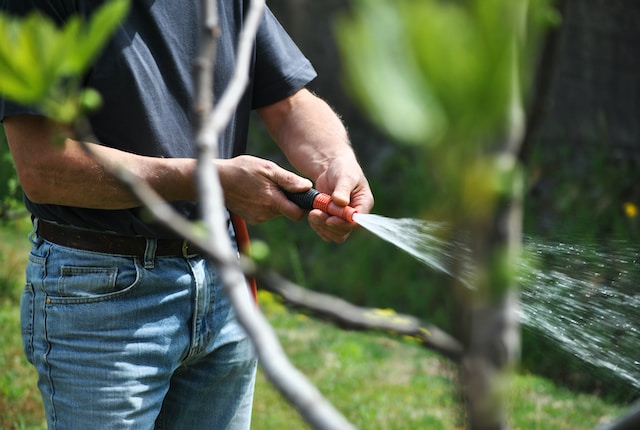
Remove everyday stains promptly
If you use your artificial grass areas for entertaining, family get-togethers or for the dogs to play, mild stains on your lawn may become part of life.
Sometimes, more stubborn stains may set in and refuse to budge. Unlike real grass, they won’t be removed with the next mowing expedition.
The best way to maintain artificial grass if you have stains is to act promptly. What you do will depend on how stubborn the stain is.
Most mild stains (dog pee, wine, tea or other everyday substances) can be removed by blotting up with a towel or kitty litter and then cleaning with water, soap, a bucket and a sponge. Then simply rinse the area with plain water.
More stubborn stains (motor oil, crayon, pen ink, etc.) can be removed by applying a three-percent solution of ammonia in water before rinsing with clean water. If that doesn’t work, try applying mineral spirits, rinsing off and blotting up. This should help to draw out the stain.
Do battle with extra-stubborn sticky stains
If a substance sticks to your artificial lawn and simply refuses to lift, you may need to go to the next level.
Substances like tree sap or chewing gum may need to be frozen using dry ice or aerosol refrigerants. They can usually then be scraped off the grass.
If you need professional assistance in dealing with an extra-stubborn stain or sticky substance that’s ruining the look of your artificial turf, call the Artificial Grass Pros.
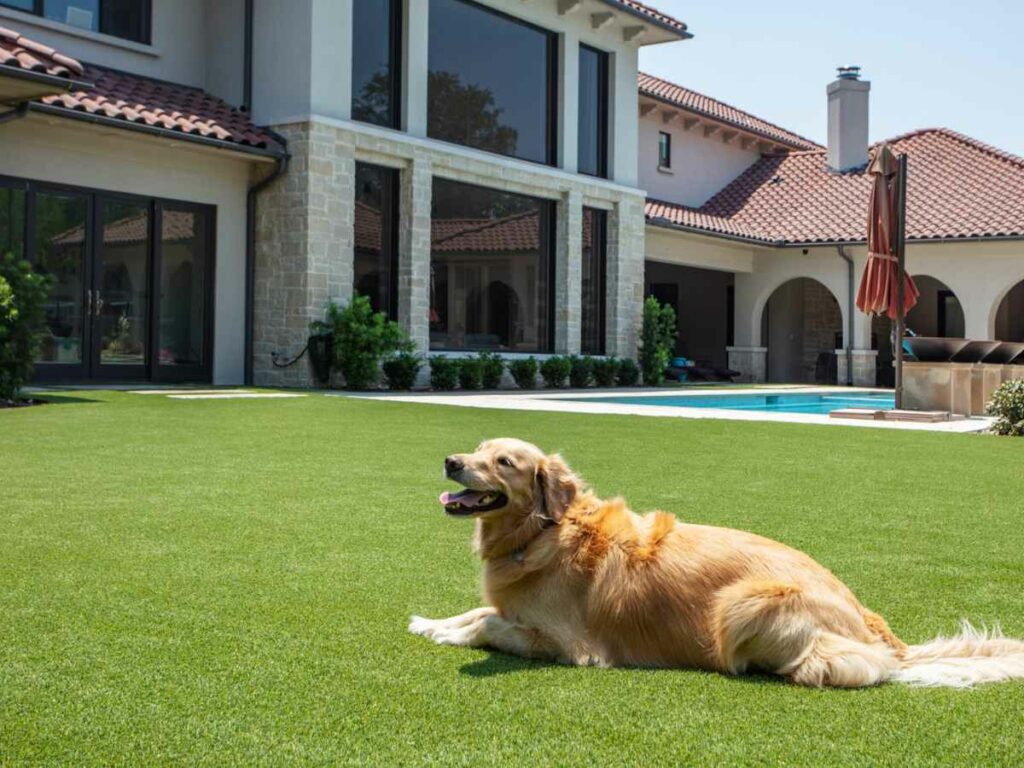
If you have pets, remove waste promptly
Pet waste left for days on your artificial turf is not a good look (or smell) for anyone. If you have dogs, perform regular checks and remove any waste as soon as possible after it’s solidified.
If your dog regularly pees on the turf you may need to remove any lingering odors by hosing off your lawn from time to time.
In Texas, many areas don’t receive the regular rainfall that will remove dog pee naturally — so homeowners need to give nature a hand from time to time.
Clear debris regularly
Another great way to maintain your artificial grass is to inspect it regularly and remove debris like leaves, twigs, soil and so on. This is especially important after high winds or thunderstorms and in autumn after the leaves fall but it may also be necessary at other times throughout the year.
For instance, after a family barbecue, food debris may also end up on your synthetic turf. This should be removed promptly to help maintain the condition of the area and also extend the lifespan of your artificial grass.
Cross-brush your grass occasionally
The infill used for artificial lawns generally keeps the grass blades in place well enough for the filaments to closely resemble natural grass. Over time, however, the blades can become compressed or matted.
Cross-brushing is the process of brushing your artificial grass “against the grain” to prevent the blades from becoming matted. It perks up your lawn and maintains its inviting appearance.
Use a brush with medium-strength plastic bristles rather than metal bristles to avoid damaging your fake turf.
Brushing like this twice a year or so can extend the lifespan of your turf, especially in high-traffic areas. It can help your fake grass last longer and will keep it looking and feeling great when you sit on it.
Repair small rips and tears
Depending on the quality of the grass you install and its daily usage, you may encounter problems from time to time with small rips and tears. This is more likely with low-quality installations and high activity — such as sports usage or boisterous dogs running around.
Small rips and tears are not major issues if they are dealt with promptly but can develop into larger problems that end up with a large repair job or even replacement.
If only part of your artificial turf sees high traffic and excessive wear and tear (such as where your dog always plays), it’s relatively quick and easy to replace it.
Call the professionals at Artificial Grass Pros for advice about this.

Remove weeds using a natural herbicide
What? Weeds on an artificial grass lawn?
It’s rare because the film backing on artificial turf discourages the growth of anything underneath it. Sometimes though, extra determined weeds can pop up.
Pulling these weeds up by hand can damage your artificial grass. You should use a water-based herbicide to prevent damage to your artificial turf or seek professional advice before you attempt your weed-killing expedition.
Keep these basic items in your garden shed…
To maintain your artificial grass, you’ll need a few basic pieces of equipment to make life easier. Fortunately, these should all be available in your local hardware store:
- A standard garden hose
- A lightweight plastic or bamboo rake with curved tines
- A brush with plastic bristles
These items will help keep your artificial grass clean and maintain a fresh and unmatted appearance to the fibers.
If you want to get a little more serious, invest in a leaf blower/lawn vacuum to get rid of any debris that may attract moisture and insects.
Avoid doing these three things…
You now know what to do to maintain your artificial grass — but the final tip is about what NOT to do.
First, keep cigarettes and fireworks away from your artificial grass or you’re going to get permanent burn marks. Not a good look.
Next, don’t use brushes or rakes with metal bristles or tines as these can damage your lawn.
Third, never use harsh chemicals to remove stains or clean your turf. If in doubt, check with the manufacturer or seek professional advice.
How to maintain artificial grass with dogs?
We’ve already covered removing dog waste in tip four.
An additional step you can take if you have dogs is to consider using PE-51, which cleans and deodorizes artificial turf and prevents fleas. It is a natural product that combines five enzymes to eliminate germs, dirt, harmful bacteria and odors.
Protecting your artificial grass investment
When you exchange the excessive water costs and hours spent tending a grass lawn for artificial turf, you’re making a sound investment.
You should protect that investment. Fake grass is not totally maintenance-free if you want to keep it looking and feeling fresh.
Fortunately, anyone can perform a few simple maintenance tips: simply brush your turf down, remove debris and stains, clean and rinse with a hose and repeat that process as often as you can (monthly is good for most homeowners).
If you need more information on how to maintain artificial grass, check out the STC’s Guidelines for Maintenance of Infilled Synthetic Turf Sports Fields, which is available in English and Spanish.
You can find out more about our professional artificial turf services and let us know what you need by contacting Artificial Grass Pros.

